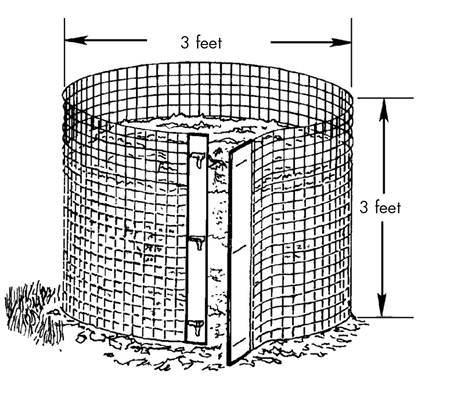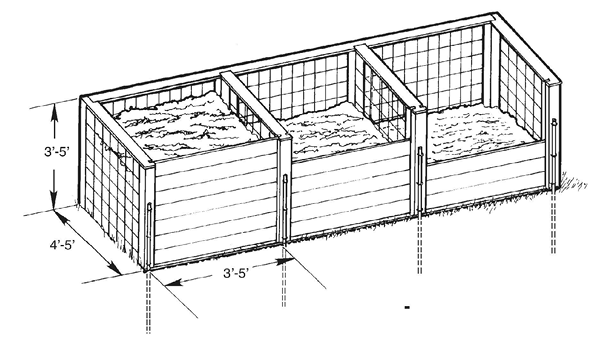Composting for the Mississippi Gardener

Why Make and Use Compost?
Compost is a dark, crumbly, partially decomposed form of organic waste that has not fully decomposed into humus. Compost is an excellent soil conditioner. It is easy to handle and stores for long periods.
By some estimates, organic waste materials (such as grass clippings, leaves, and yard wastes) make up about 30 percent of the materials going to landfills. According to the U.S. Composting Council, up to 67 percent of materials going to landfills can be composted, when paper products are included. Many urban municipalities no longer accept compostable materials into the waste stream. Composting can reduce municipalities’ handling costs related to transporting, disposing, and processing organic waste materials.
By composting these organic waste materials, homeowners can produce beneficial material that can be used in the garden, lawn, and landscape. Returning these organic waste materials to the land maintains natural biological cycles. It is an ecologically sensible and environmentally safe way to use organic waste materials.
How Compost Forms
Composting is the management of the natural decomposition processes of organic matter. The components of this process (microorganisms, organic waste materials, oxygen, and moisture) are managed so the natural decomposition of organic matter operates at optimum efficiency.
The composting process produces both heat and carbon dioxide that is released into the atmosphere. Water is released back into the environment. When composting is complete, the volume of organic matter can be reduced up to 50 percent.
For compost to form, the organic waste must go through a thermophilic (heating) cycle that is driven by the decomposition microorganisms. This heating cycle can take up to 6 months or more to complete.
Microorganisms are responsible for the natural decomposition of organic matter when composting. Bacteria, fungi, and actinomycetes use oxygen for respiration and produce a heat cycle through the oxidation of the carbon in the organic material. This heating cycle can be divided into four phases.
The first phase is called the mesophilic stage. In this stage, much heat is generated (95–113°F), causing a large increase in the bacterial population. The second stage is the thermophilic stage. In the thermophilic stage, the microorganism population composition changes (to include bacteria, fungi, and actinomycetes), and the heat increases (up to 160°F).
As the food sources for the microorganisms are depleted, a second mesophilic stage is reached (95–113°F). Once the microbial food supply has been consumed, the temperature decreases to ambient temperature. At this last phase, the composting process is finished.
Brown materials typically have a high carbon/low nitrogen ratio. Leaves, straw, sawdust, newspaper, yard waste, cardboard, and dry grass clippings are considered brown materials. Green materials have a high nitrogen/low carbon ratio. Fresh grass clippings, fruit and vegetable wastes, egg shells, hair, livestock manures, coffee grounds, and tea bags are considered green materials.
The microbial food supply is made up of the carbon and nitrogen contained in the organic wastes. The carbon provides the energy while the nitrogen sustains the microbial population growth for the decomposition process. The ratio of carbon to nitrogen (C:N ratio) is important for rapid and successful composting of organic waste materials. The range of C:N ratios to produce acceptable composting rates are 20:1 to 40:1, with the ideal range being 25:1 to 30:1.
This doesn’t mean your compost pile should have 20 to 40 times as much high carbon (brown) materials to high nitrogen (green) materials. The correct C:N ratio is achieved based on the organic waste materials being composted. In cases where a high nitrogen organic waste material is not available, nitrogen containing inorganic fertilizer can be substituted.
Table 1 lists some common organic waste materials and their associated carbon and nitrogen contents.
|
Organic waste materials |
C (%) |
N (%) |
C:N Ratio |
|---|---|---|---|
|
Fish scraps |
32.8 |
8.2 |
4:1 |
|
Soybean meal |
45.6 |
7.60 |
6:1 |
|
Legume hay |
40.0 |
2.5 |
16:1 |
|
Grass clippings |
41.6 |
2.46 |
17:1 |
|
Beef manure |
30.6 |
1.70 |
18:1 |
|
Yard waste |
44.5 |
1.95 |
23:1 |
|
Leaves |
44.5 |
0.93 |
48:1 |
|
Straw |
56.0 |
0.70 |
80:1 |
|
Rice hulls |
36.3 |
0.30 |
121:1 |
|
Corn cobs |
73.8 |
0.60 |
123:1 |
|
Paper |
43.3 |
0.25 |
173:1 |
|
Hardwood bark |
53.5 |
0.24 |
223:1 |
|
Cardboard |
48.2 |
0.20 |
254:1 |
|
Sawdust |
56.2 |
0.11 |
511:1 |
|
Softwood bark |
50.4 |
0.09 |
560:1 |
The composting process is more efficient with small waste particles. The waste materials should be shredded, ground, or chipped into the smallest particles that are practical. Mowing and bagging is an efficient way to handle grass clippings and leaves. Brush and tree limbs must be chipped into smaller pieces. You can purchase or rent a small shredder/chipper for this purpose.
The microorganisms also need oxygen and moisture to complete the composting process. Your compost pile should be turned or mixed at least two times per month. This turning aerates the pile, supplying oxygen to the interior for the microorganisms and speeding up the composting process.
Adequate moisture is also needed, with optimum microbial activity at about 50 percent moisture by weight. Proper moisture content encourages the growth of the microorganism populations. Decomposition and composting will stop when the moisture levels drop below 15 percent. A great deal of water is lost through evaporation via high ambient temperatures and the composting process itself. It may be necessary to add water during times of limited rainfall. A good time to check moisture status is when turning the pile. Add enough water to dampen the pile. Overwatering can lead to water logging conditions (anaerobic), which slows the composting process and creates foul odors (see Table 2 for common compost problems).
|
Symptom |
Problem |
Solution |
|---|---|---|
|
Bad odor |
Not enough air |
Turn the materials in the pile; add dry material if too wet |
|
Center of pile is dry |
Not enough water |
Moisten and turn pile |
|
Compost damp and warm only in the middle |
Too small; cold weather |
Collect and add more material; turn pile to aerate |
|
Pile is damp and sweet-smelling but will not heat up |
Lack of nitrogen |
Add nitrogen source, green material, or nitrogen fertilizer |
|
Interior looks or smells charred |
Extremely high temperature |
Pile is too large; reduce size, add water |
When Is Compost Ready to Use?
Compost is ready to use when the pile has cooled back to ambient temperature. Finished compost is dark and crumbly with a fresh, earthy smell. Typically, the composting process takes 6 months or more to complete. The composting process is dependent on the type of organic waste materials, environmental conditions, and homeowner care of the compost pile. In most cases, it is beneficial to screen the finished compost using a one-fourth to one-half-inch hardware cloth screen to remove any remaining large pieces.
How Is Compost Used?
Compost is used primarily as a soil amendment and a mulching material. Compost adds texture to sandy soils, improving water-holding capacity. When added to clay soil, it breaks up the small clay particles and improves drainage. Using compost also has these benefits:
- Increases earthworm and soil microorganism populations.
- Reduces soil compaction and soil crusting.
- Provides a source of slowly available nutrient recycling.
- Saves the homeowner money by avoiding the cost of soil conditioners and other bagged materials.
When using compost as a mulching material, use a 1-inch-thick layer (or about 4 yd3/1000ft2). When planting trees and shrubs, amend the soil with compost up to 50 percent by volume.
Building Your Compost Pile
Building a compost pile is usually described in terms of layers, but the layers in a compost pile may not be clearly defined. Layering in a compost pile is not really necessary, but it does give the quickest and most complete decomposition of the organic waste materials. A good layering model to follow is the lasagna method. It is a simple layering system that can be used with any compost bin or system.
Alternate layers of brown material with layers of green material. The brown layers should be at least two times as thick as the green layers. The addition of a thin layer of soil with each layer helps to inoculate the compost pile with microorganisms. Thoroughly moisten the layers to ensure adequate initial moisture content.
In order to have enough of the right organic materials, you may have to stockpile dry, brown materials in the fall, winter, and early spring to have them on hand when green materials such as grass clippings become available.
When you compost materials with high C:N ratios, you should layer them with materials with low C:N ratios. Adding a nitrogen fertilizer can bring the C:N down and closer to an optimum level for more rapid decomposition. Materials with high moisture content, such as fresh livestock manures or grass clippings, should be mixed with dry materials.
What Materials Cannot Be Composted?
While all organic materials will decompose, not all are suitable to be included in your compost pile. Here are some things to avoid:
- Diseased plant material. Diseases can be returned to the garden or spread to other areas of your yard.
- Weedy plants that have gone to seed. Weed seeds being returned to the garden create and increase weed problems.
- Grease, fats and oils, meat scraps, or bones. These may attract dogs or other animal and insect pests, and they may cause an offensive odor.
- Sawdust or wood shavings from preserved wood. These may contain harmful chemicals.
Size of the Compost Pile
The size of a compost pile can vary depending on how much organic waste material is available. The pile has to be big enough to maintain heat and moisture for the microorganisms. Typically, a compost pile 3 feet wide by 3 feet high is sufficient; anything smaller and the organic waste will not decompose properly (Figure 1).

If you have large quantities of organic waste available, the piles can be bigger. In circumstances with large quantities of organic waste, two or three individual piles may give more flexibility than a single, large pile. In this situation, three piles would be ideal, with one pile finishing, a second pile in the process of decomposition, and the third pile receiving additions of fresh materials. In this way, you could have a continuous supply of compost throughout the year.
Composting Structures
While the easiest method of composting organic waste material is simply making a pile, you may want to have a type of bin or enclosure. There are many different designs, shapes (any convenient shape), and suitable materials. You can use woven wire fencing, wooden slat fencing, cement blocks and bricks, wooden pallets, and scrap lumber for your enclosure. The sides should be loose enough to allow air circulation. One side should open easily to allow turning and removal of finished compost.
An efficient and durable structure for fast composting is a three-chambered bin. The three chambers work on an assembly line idea, having batches of compost at various stages of decomposition. A balanced mixture of waste materials is started in the first bin and allowed to heat up. Next, it is turned into the middle bin, while a new batch of material is started in the first bin. Finally, the material in the middle bin is turned into the last bin to cure to its finished compost. To make this structure, it is best to use treated lumber. Each bin should be about 5 feet by 3 feet and 4 feet high. This will have a capacity of about 2 cubic yards (Figure 2).

Many types of composting bins are available through gardens centers, mail-order catalogs, and the Internet, if you do not want to build your own bin.
Where to Make Your Compost Pile
Your compost pile should be in a convenient location. Don’t put your compost pile in an area of poor drainage where water may stand. While a shady area is best to help control ambient temperatures around your compost pile, tree roots may spread quickly into your compost pile because of the cooler temperatures, high moisture content, and nutrients available in your compost. These tree roots could make it difficult to dig in and around your compost pile.
Care of the Pile
The organic waste in your compost pile or bin will decompose naturally if left alone. You can take steps to increase the rate of decomposition.
Turning or mixing the compost pile accomplishes a couple of important things. It will evenly distribute the heat generated and bring oxygen into the center to be used by microorganisms.
Anytime fresh materials are added to the pile, they should be mixed into the center. Inserting a perforated drainage pipe into your compost pile is another way to introduce oxygen to the center of the compost pile or bin.
Moisture is important for the health and activity of the microorganisms; you will see less activity when the pile is dry. During periods of drought, the compost pile should be watered. Compost that is excessively wet can lead to anaerobic conditions and will have a bad smell. During periods of heavy, prolonged rain, placing a tarp on the pile can help to control the moisture content.
References
Stoffella, P. J., & Kahn, B. A., (Eds.). (2001). Compost utilization in horticultural cropping systems. CRC Press, New York, NY.
Publication 1782 (POD-08-23)
Reviewed by Jeff Wilson, PhD, Assistant Professor, North Mississippi Research and Extension Center. Revised by Gary R. Bachman, PhD, Extension/Research Professor (retired), and Donna Beliech, Horticulture Area Extension Agent, from an earlier edition by Beliech and David Tatum, PhD, Extension Professor (retired).
The Mississippi State University Extension Service is working to ensure all web content is accessible to all users. If you need assistance accessing any of our content, please email the webteam or call 662-325-2262.


